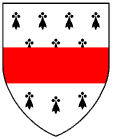
LIVES OF THE BISHOPS OF EXETER
THOMAS DE BUTTON, or BITTON, a native of Gloucestershire, and of a worshipful family, was promoted from the deanery of Wells to the see of Exeter in November, 1292 (Prynne's 'Records,' vol. iii. p. 474), and the temporalities were restored to him on 2nd December that year. Unfortunately his register has long since perished, but in that of his successor Walter Stapeldon is preserved (fol. 28) the interesting report of his visitation of the collegiate church of Boseham, in Sussex, on 28th July, 1294; and again (in folio 175) his appropriation to his dean and chapter here of the church of St. Uvelus or Ewal in Cornwall. The original instrument, dated Exeter, 15th October, 1297, with the beautiful seal of the bishop attached, is carefully preserved in their exchequer-room, with King Edward I.'s license, dated 10th April following.
In 1292 the bishop appropriated to St. John's Hospital at Wells, the church of West Down; and two years later obtained a market for Paignton, and also for Newport, near Barnstaple.
A curious document may be seen in the episcopal archives here, namely, a grant of forty days' indulgence, by three several archbishops and five bishops, dated at Rome A.D. 1300, in the sixth year of the pontificate of Boniface VIII, in favour of all true penitents who should avail themselves of our bishop's ministry, or pray for his prosperity during his life, or for the repose of his soul after his death, and for the departed souls of his parents, brothers, and sisters. Three of the eight seals originally attached to the instrument are in fair preservation, those of Basil archbishop of Jerusalem, of Adenulphus bishop of Cosenza, and Manfred bishop of St. Mark's, Venice. The rest have perished.
In nearly the beginning of Bishop Bronescombe's 'Register,' 'already mentioned, is sewed in Bishop Bitton's purchase-deed, dated Sunday before St. Laurence, 1302, by which he obtained the estate of Kelly, in the parish of St. Alun, Cornwall, of William de Rostourek, for ten pounds of silver. His sensible regulations for the collegiate church of Crediton are printed in the 'Monasticon' of the diocese, p. 445.
To his dean and chapter on 15th October, 1297, he had granted the church of St. Uvelus in Cornwall for the perpetual maintenance of his obit, and to the abbey of Tavistock on 26th August, 1304, he appropriated the church of Barrington, and on 31st December, 1305, he assigned the church of Walkhampton to the use and benefit of the abbot and convent of Buckland.
Our bishop was unable to attend the parliament summoned to meet at Carlisle within the octave of St. Hilary, 1307, the last year of the reign of King Edward I., to treat "super ordinatione et stabilitate terræ Scotiæ" ('Placita Park' Lond. edit. 1661, p. 319). According to the 'Chronicon' of Exeter Church he died on 17th September that year (Hoker says 21st), but we prefer the authority of the Cathedral Calendar, or Martyrologium, which states it to be on 25th September, and was buried just before the lowest step of its high altar. According to Leland, the gravestone was inscribed THO: ByTTEN . EPVS . EXON: ('Itin.' vol. iii. p. 57). It was embellished with a sepulchral brass.
That he was a general favourite among his episcopal brethren of the province of Canterbury is evident, from the encouragement they gave to the faithful of their respective dioceses "ad orandum pro animâ bonæ memoriæ Thomas, quondam Exoniensis Episcopi."
Godwin commemorates the tasteful decorated brass on his tomb; but that has long disappeared. In relaying the floor of the choir in August, 1763, a large slab was removed, covering a very shallow walled grave, in which lay a leaden coffin of ancient shape, six feet long; the upper part was partly decayed - the skeleton was nearly entire. On the right side stood a small chalice covered with a paten, and a piece of silk or linen was wound round the stem; amongst the dust was discovered a fair gold ring, with a large sapphire, and on the left were some fragments of a wooden crosier. The remains were respectfully covered in, but the ring and chalice are preserved in the chapter-house. In the inventory of the cathedral plate, A.D. 1327, the bishop is recorded as the donor of two silver candlesticks, parcel gilt, weighing one hundred and eleven shillings and eight pence, and of a silver holy-water vase, with two sprinklers, weighing one hundred and one shillings.
Arms: - Ermine, a fess, gules.
